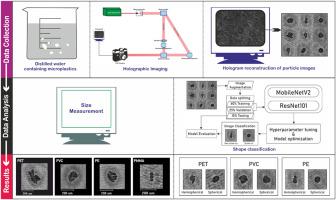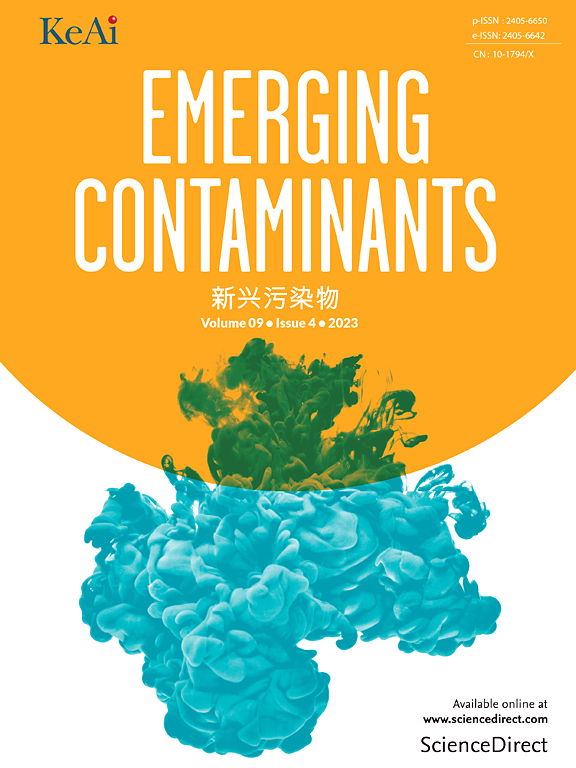Holographic imaging and machine learning for microplastic size and shape analysis in water
IF 6.9
2区 环境科学与生态学
Q1 ENVIRONMENTAL SCIENCES
引用次数: 0
Abstract
Microplastics are a growing global concern, particularly in drinking water, due to their potential negative impacts on human health. To effectively monitor, quantify and understand the sources and implications of microplastics in water, it is critical to identify their physical and chemical properties. However, existing laboratory-based methods popularly used for characterising microplastics have several limitations. Using a novel method, this study explored the feasibility of quantifying the physical properties of microplastics in water. Specifically, we utilised a portable holographic camera to record digital holograms of commercial microplastics floating in water. Furthermore, we developed a simple Python algorithm to determine the size of the microplastics from the particle images. This study also evaluated and compared the performance of two deep-learning architectures, MobileNetV2 and ResNet101, in classifying the shapes of the microplastic particles into spherical and hemispherical shapes. Findings from this study demonstrate the capability of the proposed holographic system to rapidly and automatically produce particle images of microplastics while simultaneously measuring their sizes. Performance metrics, including accuracy, precision, recall, F1 score, confusion matrix and training time, showed that MobileNetV2 achieved the best performance despite being a more lightweight model with fewer parameters than ResNet101. Therefore, MobileNetV2 was recommended for classifying the shapes of microplastics from particle images. The time and cost-effectiveness of the proposed digital holographic method make it suitable for large-scale monitoring of microplastics in water. This will be significant in identifying the sources, understanding their behaviour and reducing the associated health risks to humans.

用于水中微塑料尺寸和形状分析的全息成像和机器学习
微塑料对人类健康的潜在负面影响日益引起全球关注,特别是在饮用水中。为了有效地监测、量化和了解水中微塑料的来源和影响,确定它们的物理和化学性质至关重要。然而,目前广泛用于表征微塑料的基于实验室的方法有一些局限性。本研究采用一种新颖的方法,探索了量化水中微塑料物理性质的可行性。具体来说,我们利用便携式全息相机记录了漂浮在水中的商业微塑料的数字全息图。此外,我们开发了一个简单的Python算法,从颗粒图像中确定微塑料的大小。本研究还评估并比较了两种深度学习架构(MobileNetV2和ResNet101)在将微塑料颗粒的形状分类为球形和半球形方面的性能。这项研究的结果表明,所提出的全息系统能够快速、自动地产生微塑料的颗粒图像,同时测量它们的尺寸。包括准确率、精密度、召回率、F1分数、混淆矩阵和训练时间在内的性能指标表明,尽管MobileNetV2是一个比ResNet101更轻量、参数更少的模型,但它取得了最好的性能。因此,建议使用MobileNetV2从颗粒图像中对微塑料的形状进行分类。所提出的数字全息方法的时间和成本效益使其适合于水中微塑料的大规模监测。这对于确定污染源、了解它们的行为和减少对人类的相关健康风险具有重要意义。
本文章由计算机程序翻译,如有差异,请以英文原文为准。
求助全文
约1分钟内获得全文
求助全文
来源期刊

Emerging Contaminants
Medicine-Public Health, Environmental and Occupational Health
CiteScore
10.00
自引率
6.70%
发文量
35
审稿时长
44 days
期刊介绍:
Emerging Contaminants is an outlet for world-leading research addressing problems associated with environmental contamination caused by emerging contaminants and their solutions. Emerging contaminants are defined as chemicals that are not currently (or have been only recently) regulated and about which there exist concerns regarding their impact on human or ecological health. Examples of emerging contaminants include disinfection by-products, pharmaceutical and personal care products, persistent organic chemicals, and mercury etc. as well as their degradation products. We encourage papers addressing science that facilitates greater understanding of the nature, extent, and impacts of the presence of emerging contaminants in the environment; technology that exploits original principles to reduce and control their environmental presence; as well as the development, implementation and efficacy of national and international policies to protect human health and the environment from emerging contaminants.
 求助内容:
求助内容: 应助结果提醒方式:
应助结果提醒方式:


